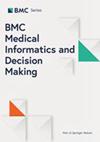Development of message passing-based graph convolutional networks for classifying cancer pathology reports
IF 3.3
3区 医学
Q2 MEDICAL INFORMATICS
引用次数: 0
Abstract
Applying graph convolutional networks (GCN) to the classification of free-form natural language texts leveraged by graph-of-words features (TextGCN) was studied and confirmed to be an effective means of describing complex natural language texts. However, the text classification models based on the TextGCN possess weaknesses in terms of memory consumption and model dissemination and distribution. In this paper, we present a fast message passing network (FastMPN), implementing a GCN with message passing architecture that provides versatility and flexibility by allowing trainable node embedding and edge weights, helping the GCN model find the better solution. We applied the FastMPN model to the task of clinical information extraction from cancer pathology reports, extracting the following six properties: main site, subsite, laterality, histology, behavior, and grade. We evaluated the clinical task performance of the FastMPN models in terms of micro- and macro-averaged F1 scores. A comparison was performed with the multi-task convolutional neural network (MT-CNN) model. Results show that the FastMPN model is equivalent to or better than the MT-CNN. Our implementation revealed that our FastMPN model, which is based on the PyTorch platform, can train a large corpus (667,290 training samples) with 202,373 unique words in less than 3 minutes per epoch using one NVIDIA V100 hardware accelerator. Our experiments demonstrated that using this implementation, the clinical task performance scores of information extraction related to tumors from cancer pathology reports were highly competitive.开发用于癌症病理报告分类的基于消息传递的图卷积网络
研究证实,将图卷积网络(GCN)应用于利用词图特征(TextGCN)对自由形式的自然语言文本进行分类,是描述复杂自然语言文本的有效方法。然而,基于 TextGCN 的文本分类模型在内存消耗、模型传播和分发方面存在弱点。在本文中,我们提出了一种快速消息传递网络(FastMPN),它实现了具有消息传递架构的 GCN,通过允许可训练的节点嵌入和边缘权重,提供了通用性和灵活性,帮助 GCN 模型找到更好的解决方案。我们将 FastMPN 模型应用于从癌症病理报告中提取临床信息的任务,提取了以下六个属性:主要部位、亚部位、侧位、组织学、行为和分级。我们根据微观和宏观平均 F1 分数评估了 FastMPN 模型的临床任务性能。并与多任务卷积神经网络(MT-CNN)模型进行了比较。结果表明,FastMPN 模型等同于或优于 MT-CNN。我们的实施表明,我们的 FastMPN 模型基于 PyTorch 平台,使用一台英伟达 V100 硬件加速器,每个历时不到 3 分钟就能训练出包含 202,373 个独特单词的大型语料库(667,290 个训练样本)。我们的实验表明,使用该实现,从癌症病理报告中提取肿瘤相关信息的临床任务性能得分极具竞争力。
本文章由计算机程序翻译,如有差异,请以英文原文为准。
求助全文
约1分钟内获得全文
求助全文
来源期刊
CiteScore
7.20
自引率
5.70%
发文量
297
审稿时长
1 months
期刊介绍:
BMC Medical Informatics and Decision Making is an open access journal publishing original peer-reviewed research articles in relation to the design, development, implementation, use, and evaluation of health information technologies and decision-making for human health.

 求助内容:
求助内容: 应助结果提醒方式:
应助结果提醒方式:


